Elderberry Plant Identification – Sambucus canadensis
Heads up
Common in various parts of North America, the elderberry is not only a visual delight but also a source of nutrition and even medicine. Knowing how to identify it can unlock a world of possibilities.
The elderberry goes by the scientific name Sambucus canadensis and belongs to the Adoxaceae family. Many know this plant by its other common names, such as American elderberry or wild elder.
Elderberry: Key Parts in Photos






Where to find it
If you’re someone who loves strolling through nature or has a backyard that brushes with the wild, you might be walking past elderberries without even realizing it. They’re predominantly found in the wetter areas like riverbanks, forests, and even roadsides. Their ability to thrive in these damp environments makes them an exciting find during a trek or a simple walk in the park.
How to identify elderberry
Now, let’s get to the crux of identifying this plant. You might think that the berries are the most noticeable part, but before they even appear, the bark sets the elderberry plant apart. The bark is distinctive and has a yellowish-gray to grayish-brown hue. If you take a closer look and perhaps even break a small twig, you’ll notice a white pith inside. It’s an unmistakable feature that can serve as an initial clue to the plant’s identity.
But don’t just stop at the bark. The leaves offer more hints. The elderberry has compound leaves, typically made up of seven leaflets. These leaflets have sharply serrated edges. The tips of these leaflets are pointed, and when light hits them, you can observe the dark green hue on the upper surface and a contrasting lighter green on the lower side.
The elderberry flowers are a visual treat. They are lemon-scented and have a creamy-white color that stands out against the green backdrop. These five-petaled beauties come together in large clusters, sometimes spreading out up to 10 inches across.
After the flowering season, as the petals drop, the transformation to fruits begins. These aren’t just any fruits. The elderberry fruits are small, rounded, and have a purplish-black color. You can find them in clusters, and each fruit is about 0.2 inches in diameter, resembling a tiny bunch of grapes. If you’ve identified the plant correctly and are sure about any adverse reactions, these berries can be a delightful addition to your diet.
